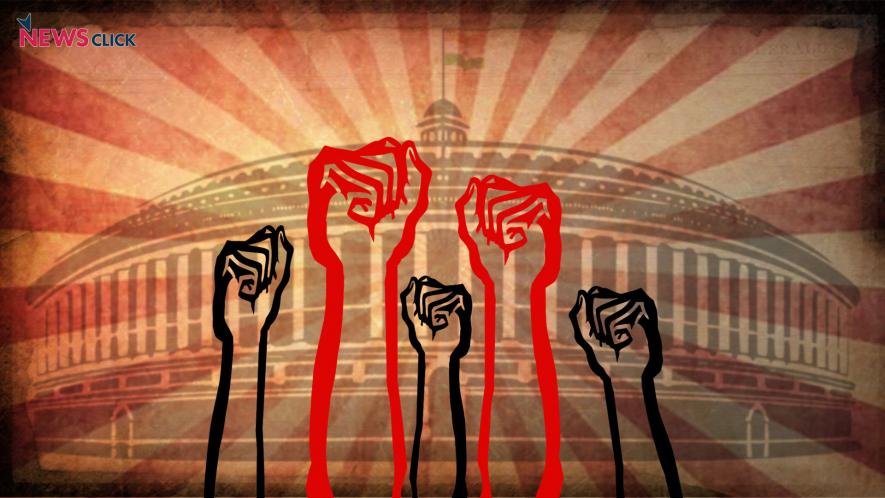Workers’ Mahapadav: Wages Not Enough to Even Survive

Credits: Nitesh Kumar
One of the key demands of lakhs of workers assembling in Delhi on 9-11 November to confront the government is increase in minimum wages. They are demanding that a country-wide minimum wage of Rs.18,000 should be declared by the government. Also, they demand that henceforth it should be linked to the Consumer Price Index. That means that as price of what they need rise, their wages should go up equally.
Reports from all over the country and across all sectors indicate that workers and employees are facing a tremendous squeeze on their family budgets because of constantly rising prices. According to a survey report published by the govt. run Labour Bureau, about 57% of wage earning workers earn Rs.10,000 per month or less. In fact, nearly 20% or one in five of workers gets Rs.5000 or less per month.
In most states, the statutory minimum wages declared by the State governments are only on paper because the bulk of employers do not implement them. Although this is a gross violation of the law, the labour law enforcement machinery is defunct and employers bribe their way through the weak attempts if any made by workers to get their legal rights. It is only when workers are organized with strong trade unions that they can manage to get minimum wages.
Even in the organized sector the condition of wages is pathetic. According to the Annual Survey of Industries (ASI) brought out by the govt.’s Central Statistical Office (CSO), in 2014-15 the average wage per worker was just Rs.10,000 per month.
The situation is all the more dire for lakhs of contract and casual workers whose wages are not even linked to the statutory minimum wages declared by state or central govts. According to the Labour Bureau’s report, 87% of contract workers get Rs.10,000 or less per month. A survey done by CITU last year showed that among all the big industrial sectors like steel, coal, transport, plantation, port and dock, etc. contract workers were earning roughly half of what their regular counterparts earned in the same industry. Employing contract workers has become the method of choice for employers to push down wages and escape labour laws. The condition of casual workers, who make up one third of workforce in India, is even worse with over 96% earning less than Rs.10,000 per month.
In most places, workers are so desperate that they are forced to accept work for 10 or 12 hours, often at normal wage rates (not double as stipulated for overtime) just to make ends meet. In other words, the harsh exploitation has effectively blown away the concept of 8-hour working day for many in India.
How does one know how much wage is needed for a worker’s family to live? It is possible to get an estimate of the bare minimum requirement – enough to keep skin on bone, as workers ruefully say – by using a formula first accepted by the 15th Indian Labour Conference (ILC), which is a body made up of workers, employers and govt. In 1957 the ILC agreed that minimum wage should be worked out by taking the cost of following items for a workers’ family of two adults and two children:
1) Per capita food intake of at least 2700 calories for a worker’s family comprising three units (2 adults units + 2 children equivalent to 1 unit)
2) Per capita cloth of at least 18 yards per annum
3) Provision of housing as per minimum rent charged by government industrial housing scheme for low-income category
4) 20 per cent of the above total to be added for fuel, lighting, miscellaneous expenditures.
In addition, the Supreme Court stipulated in 1992 that an additional 25 per cent of the above total should be further added to cover for education, medical expense, recreation and provision of old age and marriage while fixing minimum wage.
If you do the maths, this will work out to about Rs.20,000 per month. The central govt. has agreed to pay Rs.18,000 per month as the minimum wage for its own employees, based on Seventh Pay Commission recommendations. If this is the rate at which govt. employees get paid, why should other workers get less wages. Cost of living is the same for a govt. employee and an industrial worker or a scheme worker. Why shouldn’t they get same wage? In fact the workers are demanding Rs.18,000 as the minimum wage.
On the other hand, big corporate houses, both domestic and foreign, continue to reap super profits. The govt., instead of providing some relief to workers, is dancing to the tune of monopolists like Ambanis, Adani, Tatas and Birlas, receiving directions from industry bodies like CII and FICCI. Their super profits are sought to be maintained by cutting “costs” of labour – by throwing workers out, by reducing or freezing wages and by contractualisation. A recent study has shown that income inequality is now the highest ever in record, surpassing the levels found in 1922 under the British colonial rule.
Instead of accepting this just demand and amending the Minimum Wages Act accordingly, the BJP led government has introduced the Code on Wages Bill in the Lok Sabha, which has no mention of the 15th ILC formula and Supreme Court directions. In fact, it is an effort to remove wage fixation from the ambit of labour laws altogether.
Disclaimer: The views expressed here are the author's personal views, and do not necessarily represent the views of Newsclick.
Get the latest reports & analysis with people's perspective on Protests, movements & deep analytical videos, discussions of the current affairs in your Telegram app. Subscribe to NewsClick's Telegram channel & get Real-Time updates on stories, as they get published on our website.
























